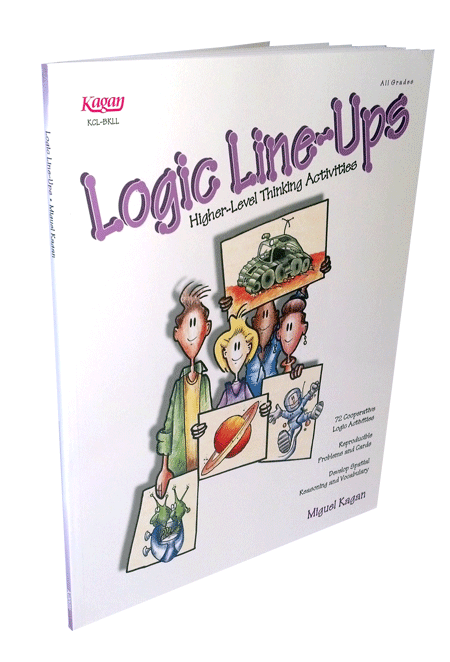
Logic Line-Ups
Higher-Level Thinking Activities
- 72 cooperative logic activities across 12 themes.
- Includes reproducible problems and cards for teams, pairs, or individual activities.
- Builds students' deductive thinking skills, spatial vocabulary, spatial reasoning, and teamwork skills.
| BKLL • $19 | |
| Buy PDF eBook | |
Develop your students' thinking skills with hands-on cooperative logic activities. You copy the provided picture cards and clues for your students. They work in teams to figure out how to use the clues to line up their cards in the correct order. Build your students' deductive thinking skills, spatial reasoning, spatial vocabulary, and teamwork skills with these 72 ready-to-use, logic activities. You'll find problems, answers, and reproducible line-up cards for 12 popular themes: barnyard, bugs, dinosaurs, fantasy, holidays, nutrition, occupations, outer space, pets, seasons, shapes, and under the sea. Includes full-page, reproducible cards for whole-class activities and quarter-page cards for the team, pair, and independent activities described. Learning how to think has never been so much fun. 88 pages.
Sample Page
Click on the image to view and/or print it full size.
I recently attended a Kagan Workshop and was introduced to this resource after using some of the activities in the session. I was looking for a tool that could be used with whole groups and small groups of students and this was the one. Not only is it interactive and gets students up on their feet, it's a great way for students to work in cooperative groups, while at the same time learning how to think and interpret directions. Logic Line-Ups will be a lifesaver for me this school year, when working with both groups of students as well as adults. This was the best purchase I made this year!
—Audrienne Womack
Teaching and Training Hints
Logic line-ups problems describe how students are to line up. If you want to avoid possible confusion, there are two things that need to be established before students line up.
1. Perspective.
If the problem includes direction terms such as "right," "far left," or "to the left of," students will line up differently if they are using THEIR left and right or the left and right of the OBSERVER. Let students know which you intend in advance.
2. Sequence.
After establishing what "left" and "right" mean, establish where the line starts and ends. Decide whether to have students line up from left to right or right to left when the problem includes sequencing terms such as "first" "last," or "third."
If you're looking for one of those "Aha" moments and are OK with a little confusion, don't establish sequence or perspective in advance. Let students line up according to how they interpret the problem. Hopefully, teams will interpret the problem differently or their solution won't match your answer. This is great teaching opportunity.
About the Book
In the book Logic Line-Ups, the problems are all designed as follows:
• Perspective – From the perspective of the observer (not students)
Using the perspective of the observer is more difficult as it requires visual perspective-taking. For younger students, consider changing the problems or answers to use students' left and right.• Sequence – First to last from left to right (i.e., First, Second, Third, Last)
Book Typo
There is a typo in the book.
On the Bugs problem page (p. 14), Problem 1, step 2 now reads:
1. The bee is not second.
It should read:
1. The bee is not third.
We will fix this typo on the next printing of the book.

